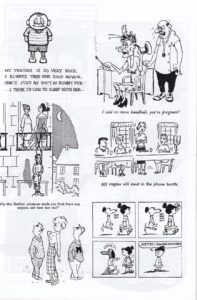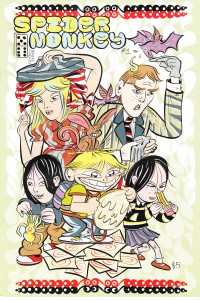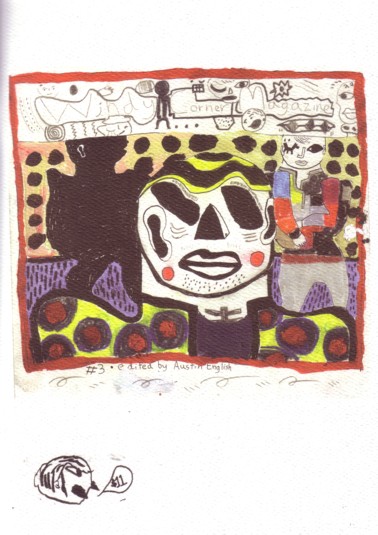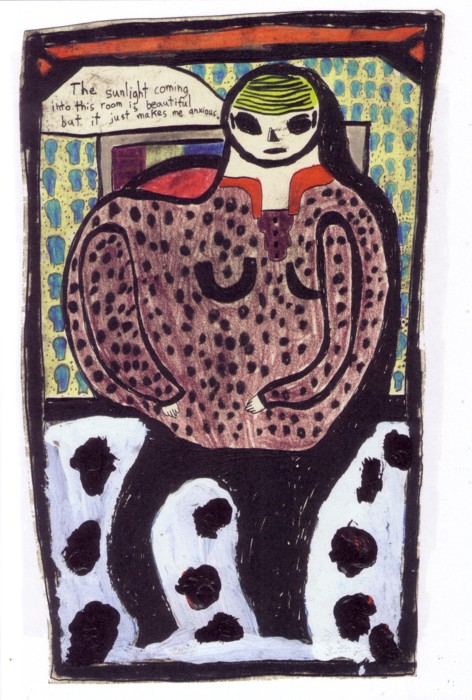We can all agree that the world would be a better place with more Magic Whistle in it, but Sam Henderson is just one man with other demands on his attention. What’s the solution to this problem? Bring in more funny artists! That’s the general idea with this latest version of Magic Whistle, and it’s a fantastic idea that works splendidly in this first issue. Sam does his thing better than most funny people so you know going in that that’s going to be good (check the handy chart to see what gum is called in your state; Ohio is “Pennsylvania asparagus”). But what about the newbies? Well, to start with, I think they’re all oldbies (i.e. people who have been making comics for years now), so no worries on that front either. John Brodowski (if you’re a regular around here that should be a familiar name) has a series of strips involving Sid and Sid (basically a carnival barker and a mute ghoul, although it’s probably best not to know for sure exactly what they are) spreading knowledge and horror wherever they go. Manuel Gomez Burns picks apart the traditional gag comic, spending a lot of time with the character in the last panel who always plops over in horror/outrage/hilarity and exactly what might make this character tick outside of the frame. Leah Wishnia devises the ingredients necessary to create the perfect spitball and show the devastating effects of such an object. Jesse McManus’s comic might require some knowledge of older Magic Whistle strips (mostly the ones where the bear and the human exchange body parts with each other with joy and hilarity), but he injects some unsettling realism into that hypothetical situation. Finally there’s Ansis Purins, another familiar name to regulars around here, with an oddly sweet tale of brothers with little in common who go out to plant a tree. And because it’s Ansis, some version of zombres are of course involved. Here’s hoping that increasing the pool of funny means more Magic Whistles in the world, because we’re all going to need something to laugh about over the next few months, he said, injecting a slight political note into an otherwise non-partisan review. Don’t vote Trump, you dummies. But do buy this comic, because it’s funny. $5.99
English, Austin & McManus, Jesse – Spider Monkey #1
August 5, 2014Spider Monkey #1
Why hasn’t the world put Austin English (writer) and Jesse McManus (artist) together before now? Stuff like that always seems so easy in retrospect. I should also point out that this is the first issue of a series, that it came out in 2011 and that it is now the middle of 2014 without another issue in sight. And yes, there is a continuing story, so that’s annoying, but it’s easy enough to take this as a self-contained story. This one starts off with a young boy who is able to talk to animals. The method that he uses to talk to animals is a little hard to explain, so I’m not going to bother, but I’ll just say that it’s a unique solution to the problem. Granted, I didn’t understand why his sister heard him talking to his mouse friend and only heard a series of “meows”, but maybe that’s just how all people/animal conversation sound. His sister has a unique way of connecting with the house whenever she gets home, which should also be seen to be believed, and I realize I’m dangerously close to not fulfilling any sort of useful function as a reviewer here. How about if I point out that Jesse is the perfect artist to show both things: the infestation of black lines from the animal conversations and the way reality seems to bend around Spider’s sister after she completes her route. Anyway, these two live in a strange town of some kind where they can also go see a man who custom makes masks and tells stories in them and of them. It also appears that people can get their heads split open and fix up the wound with tape, which sounds like a cartoon, although in cartoons you can’t see their brains. Mix all this together, throw in a school, some history about a performer who worked in squiggly lines and a performance from the mask maker and you have yourself a comic. It’s all a bit more linear than I made it sound, and I do hope that this isn’t yet another series that never makes it past the first issue (as I do have questions that they seemed to be on their way to answering with future stories), but either way this is well worth your time to seek out. And for $5 for this much comic there’s really no reason not to!
English, Austin – Windy Corner Magazine #3
April 23, 2010Windy Corner Magazine #3 edited by Austin English Now available! $10
It’s good to be reminded on a regular basis of just how wrong I can be. I’ve been bitching lately about the lack of readable contents pages for anthologies and how I just want to know who did which strip. This issue starts with a remarkable series of images by Lille Carre and goes seamlessly into a table of contents drawn by Molly Colleen O’Connell. There are no page numbers, the actual information is strewn about the page… and I went away from the pages knowing exactly who did what and where. Kudos. Granted, once you get past those first few pages there are fewer contributors this time around to keep track of, but it’s nice work all the same. Austin gets most of the, um, page time in this issue, as well he should. First up is part 3 of the Francis story (and I am going to go back and review the first issue soon), which deals this time only with Francis’ mother and her life. After this Austin has a couple of short pieces dealing with Austin’s formative years drawing and a trip to the museum between a father and his daughter (mostly dealing with their relationship). Sakura Maku is up next with a series of vibrant pieces about a brassiere museum, dying and being turned into a tree and a guy who was briefly married to Janet Jackson. In other words, you’ll need to read it for yourself. Jason T. Miles then draws a letter to the magazine from Jesse McManus, which is mildly odd because Jesse could certainly draw it himself, but Jason has a unique way of interpreting it. Finally there are the text pieces, as Austin talks about Garth Williams (an illustrator who influenced him greatly growing up), Frank Santoro has a review of Garage Band by Gipi (reminding me once again that what I do here is a poor substitute for actual, in-depth reviews), and Vanessa Davis interviews Carol Tyler. I’d probably pick up #2 before #3 if I just had $10 to spend, but there’s plenty in both of these issues for all comics fans. Unless you just hate Austin English for some reason, but I don’t see how that would be possible. $10





 Posted by Kevin
Posted by Kevin 








